
|   |

|   |
Lasyaprabha and Rasavat - Satish Suri e-mail:satishism@yahoo.co.in December 26, 2023 LASYAPRABHA Photos:Shandilya Srivatsa The two-day festival 'Lasyaprabha' organised by Yasomati Mishra's Nrityadhwani on 16th and 17th November at the A.D.A. Rangamandira, Bangalore, was a celebration of Odissi dance in its traditional and modern forms. The distinct and unique flavour of the events reflected the artistic vision of the curator, who blended classical and contemporary elements in their programming. The festival also honoured the legacy of Guru Kelucharan Mohapatra by featuring his choreographies performed by both established and upcoming dancers. The events were a testament to the vitality and diversity of Odissi dance, which continues to evolve and inspire new generations of artistes. 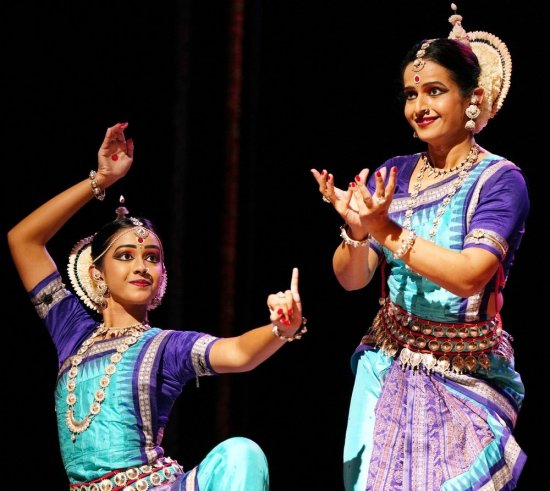 Saanvi Thakur &' Yasomati Mishra A unique combination of mother and daughter sharing the stage was the opening statement adding a beautiful layer of connection and shared artistry. The Odissi duet performance by Yasomati Mishra and her daughter Saanvi Thakur commenced with a Mangalacharan, an invocatory piece called 'Vishnu Vandana.' Set to Bijay Kumar Jena's music, it depicted prayers for auspiciousness to Vishnu, the universe's ruler and Lakshmi's beloved. The choreography by Ratikant Mohapatra allowed the artistes to showcase aesthetic beauty through synchronized movements and expressive body language. In the subsequent Pallavi, the performance exuded ecstatic joy. Set in Purnanga Varali and choreographed by Ratikant Mohapatra, it elaborated on the Pallavi theme, revealing lyrical statements interspersed with rhythmic sequences. Yasomati Mishra and Saanvi portraying their roles with flawless technique and grace, brought forth energy and exuberance throughout the performance. Preetisha Mohapatra's performance of the Pallavi in Mangaladhwani, a composition choreographed by Ratikant Mohapatra, was a brilliant display of elegance and finesse. Having been exposed to Odissi since childhood, she demonstrated her mastery of the dance form with ease. She did not merely imitate her mother Sujata Mohapatra, a renowned Odissi dancer, but has carved her niche with her talent and flair, living up to the rich heritage she inherited. "Kede chhanda janelo sahi" is a classic choreographic composition by Guru Kelucharan Mohapatra portraying mother Yashoda's astonishment at child Krishna's extraordinary abilities. The performance encompasses the loving and caring nature of mother Yashoda, Krishna's innocent and mischievous demeanour, and the character of Putana disguised to harm Krishna, and Kalia who tried to poison the river. Sujata Mohapatra executed these roles with remarkable precision and intensity, swiftly immersing herself in each character with depth and poise. 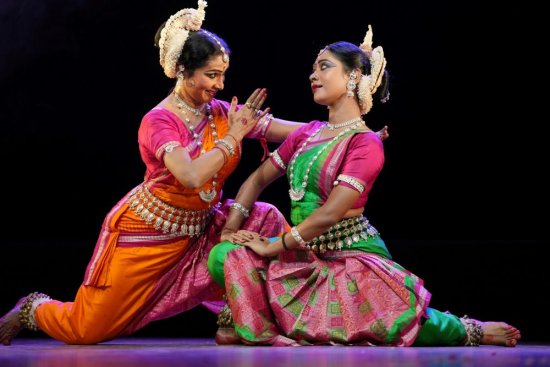 Sujata Mohapatra & Preetisha The captivating duet by Sujata Mohapatra and Preetisha Mohapatra encapsulated the essence of the day with their rendition of 'Sita Haran,' portraying six pivotal characters: Rama, Lakshmana, Sita, Hanuman, Ravana and Jatayu. The seamless transition between roles by the artistes was delightful to witness, showcasing their versatility. The portrayal of Jatayu attaining moksha was vividly brought to life by Sujata Mohapatra presenting a compelling exposition of the concept. The second day of the festival brought vibrant celebration and joy among the artistes of Nrityadhwani as they showcased their training and competence. Ganesh Vandana -Padavande is a devotional dance piece invoking Lord Ganesha for a propitious start, aiming to eliminate obstacles. Aavya Behera, Deveshi Sahoo, Sai Stubya, Sarah Agarwal, Punyatoya Samantaray, Dyumna Mohanty, Sattvika Acharya, Sunitha Ananthaseshu, Aarthi Venkataraman, Meera G, Sonali Behera, Dhristi Tripathy, Debanshi Mohanty presented this invocation. 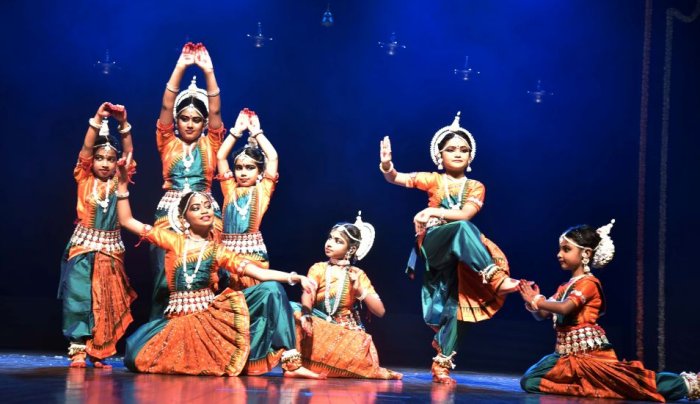 Disciples of Yasomati Mishra Saanvi Thakur presented an interesting solo dance portraying the goddess Matangi, symbolizing wisdom and success. The young learners from Nrithyadhwani, who have recently embarked on their Odissi journey, presented 'Guru Vandana,' a segment from the Guru Stotram. This piece, with original choreography by Guru Ratikant Mohapatra, featured music composed by SK Gururaj in raag Bhairavi and taal Ektaal. Alisha Behera and her daughter Aavya Behera, presented the 'Megh Pallavi,' a dance piece choreographed by Guru Ratikant Mohapatra. "Chandana charchita" from Jaydeva's Geeta Govinda performed by Alisha Behera, Saanvi Thakur, Bishnu Priya Panda, Taneshtha Pati, Shanaya Bajaj, and Yasomati Mishra brought forth the joyful moments of love between Krishna and the Gopikas, aiming to bring happiness and bliss to all devotees through its auspicious melodies. While some disciples presented the Vasant Pallavi, Yasomati Mishra and Saanvi Thakur showcased the Aravi Pallavi. Taneshtha Pati performed a solo rendition of the 'Shiva Panchakshara Stotram' in the next segment of the evening's program. "Dekha go Radha Madhaba chaali" captured the essence of the spiritual bond between Radha and Krishna. The Mohana Pallavi presented a captivating display of rhythm, expression and harmony. Yasomati Mishra's 'Durga Stutee' was the highlight of the evening, with the dancer showing total devotion, achieving a state of fulfilment and bliss. RASAVAT Photos: Prof.K.S.Krishnamurthy The thematic performance 'Rasavat' by Shashwati Garai Ghosh and her ensemble at the Bangalore International Centre on November 27th was a remarkable display of their skill and creativity. The audience was drawn into the captivating content that explored intriguing and relevant themes, delving into human emotions, senses and thoughts. Through distinct segments like invoke, stabilize, specify and celebrate, the dance explores a spectrum of experiences. Thoughtful use of props, music, and rhythms enriched the performance.. 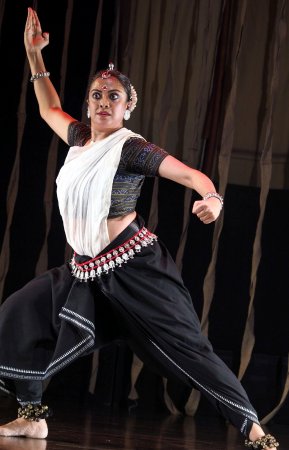 Shashwati Garai Ghosh The first segment of Rasavat commenced with an invocation to Hari, to set aside pride and calm the mind through Srjan Chatterjee's composition "Jaya Jaya Deva Hare." This piece established a vibrant tone, while Dhaneswar Swain's rhythmic sequences elevated the performance, culminating in a captivating movement vocabulary. Overall, it created an engaging and dynamic start to the presentation. In the segment dedicated to stability, the focus was on perfect technique. Debolina Sarkar and Shashwati Garai Ghosh's intonation of solfa syllables formed a backdrop for flawless execution and alluring movements in Gamana Gati. The dancers displayed flair and precision, showcasing the foundation of perfect technique. The subsequent Kriya highlighted the development of the Pataka hasta vocabulary, offering an innovative approach to expressing emotions. Srjan Chatterjee's soulful voice added depth to this emotive piece. The segment to internalize and strengthen the connection to Rasa depicted the vatsalya bhava of Yashoda, a concept originally conceived by Guru Kalanidhi Narayan, re-imagined by Sharmila Biswas and Hari Mohan Kuntia's music, Yashoda attempts to put Krishna to sleep. After failed attempts, she narrates the tale of the ten-headed Ravana and Sita's kidnapping. When Krishna awakens and beheads Ravana, she realizes her son is Rama, himself an avatar of Vishnu. Overwhelmed, she dreams of a serene life for her son in her embrace. The performance conveyed the emotional depth of the mother-son relationship with grace. 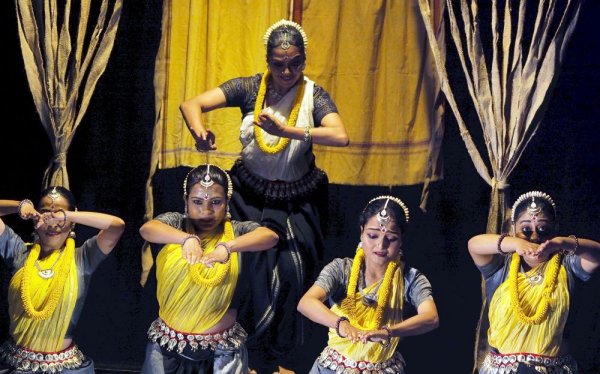 Shashwati Garai Ghosh & ensemble The finale 'Mahamaya' encapsulated the essence of our existence, invoking the power of Goddess Durga. It's a celebration, depicting Goddess Durga's battle and triumph over the demon Mahishasura. This presentation highlighted the interrelated nature of Rasa and life, emphasizing that in our daily celebrations, we experience Rasavat, going through the full range of emotions and experiences. Srjan Chatterjee's haunting melodic voice added an elegant dimension to the presentation. His vocal skills not only enhanced the mood but also enriched the ambience, contributing to the overall atmosphere of the performance, creating an immersive experience for the audience. Shashwati Garai Ghosh deserves full recognition for her conceptualization of Rasavat, as well as for her involvement in the stage props, costume design, and choreography. She brought her vision and creativity to the presentation, making it outstanding. The lighting effects by Surya Rao enhanced the charm of Ghosh's choreography and design, creating a powerful impact on the audience. 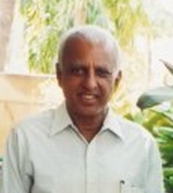 Bangalore based Satish Suri is an avid dance rasika besides being a life member of the Music and Arts Society. |